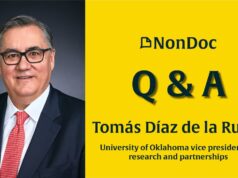
(Editor’s note: The following piece is excerpted from the fifth chapter of Tales of the Quantum by Art Hobson.)
Great art and great science have much in common. One definition of great art is that it’s unexpected yet, once experienced, perfect: a symphony’s surprising but perfect change of key, a story’s surprising but perfect turn of plot. It’s the same in science. Einstein’s “field of spatial curvature” astonished scientists, yet turned out to be the perfect framework for gravity. In just this way, quanta are not what anyone could have expected, yet they turn out to be perfect. de Broglie, with his marvelously aesthetic intuition that matter must have wave properties, was the first to sense this. The universe, it seems, is an incomparably inventive artist.
———
Why is there something rather than nothing? It’s perhaps the ultimate philosophical question, and the ultimate scientific question. In my opinion, science will get closer and closer to, but never arrive at, the answer. Nevertheless, quantum physics comes surprisingly close to answering it. But of course you’ve got to accept a few quantum principles to get to the answer, and then you can always ask: Why are there these quantum principles rather than nothing?
Here is the quantum argument. Imagine a region of space in which there are absolutely no physical phenomena of any kind — no normal matter, no radiation, no dark matter or dark energy, no other physical entity and no energy at all. Imagine, in other words, absolute nothingness throughout some region of space. It is a fundamental principle of quantum physics that such a region of space cannot exist.
———
When you picture the microworld, do not envision isolated particles moving in stately solitude through empty space; picture, instead, an ever-changing, energetic, unpredictable, crowded kaleidoscope of of various sorts of quanta in spontaneous destruction and creation. The fully fledged tale of the quantum — namely, quantum field theory — describes and predicts all of this.
It informs us that, through and through, this dynamic universe is both quantum and relativistic. The universe’s most characteristic phenomena, including the Big Bang, involve the creation and destruction predicted by quantum field theory. These processes arise spontaneously because the universe is made of energy, because energy assumes a multitude of forms randomly, and because mass and energy are equivalent. Reality is a set of space-filling fields with quanta rippling through and energy, like wind stirring a lake, generating the possibility of change, destruction, and creation.
————
Fields are all there is. This seems incredible when one considers, say, rocks and tables. How can these be simply fields, analogous to a magnetic field? It’s worth pondering…. Stop reading and slam your hand down on a table. The table slams back, as you can tell from your stinging hand. It’s a reality check. Now look at the microscopic picture: The table and your hand are made of atoms, with electrons that create EM fields. Slamming brings your hand’s electrons near the table’s electrons, and their EM fields repel each other. This repulsion by force fields against other force fields stops your hand. It all comes down to fields.
———-
The particle misconception runs deep, in part because of the widespread use of the misleading informal word particle. Despite the evidence, and although leading quantum theorists argue explicitly for the field view, a survey of textbooks in my university’s library shows most physics students are still learning that the universe is made of things called “particles.”
Quanta are not much like sand grains or tiny marbles or other classically intuitive particles. As explained in this and succeeding chapters, quanta are highly unified, extended, flexible, changeable, unpredictable, fragile, gossamer entities that flit about or vibrate at mostly enormous speeds, that can extend over vast regions yet collapse in apparently a single instant of time to atomic or far smaller dimensions, that can vanish in an instant by transforming their energy into some other form, that can burst into being from the energy of a decaying atom or from a random energy fluctuation, and that can entangle with each other to form highly unified yet delicately connected networks of composite correlated objects that appear to be in instant contact over perhaps cosmological distances.
Particle is exactly the wrong word to describe such an object. It promotes a serious misconception about our most fundamental scientific theory. For the world to become scientifically literate, as many of us think it must if it is to remain habitable, scientists must use terms that indicate their proper meaning, or that at the least do not flagrantly contradict their proper meaning. Why not use the right word: quantum?
The all-fields picture has interesting implications. Physicists regard fundamental fields to be conditions of space. So electrons, photons, atoms and molecules are conditions — “states” or “shapes” — of space.
So cabbages, kings, and your foot are made of states of space.





















